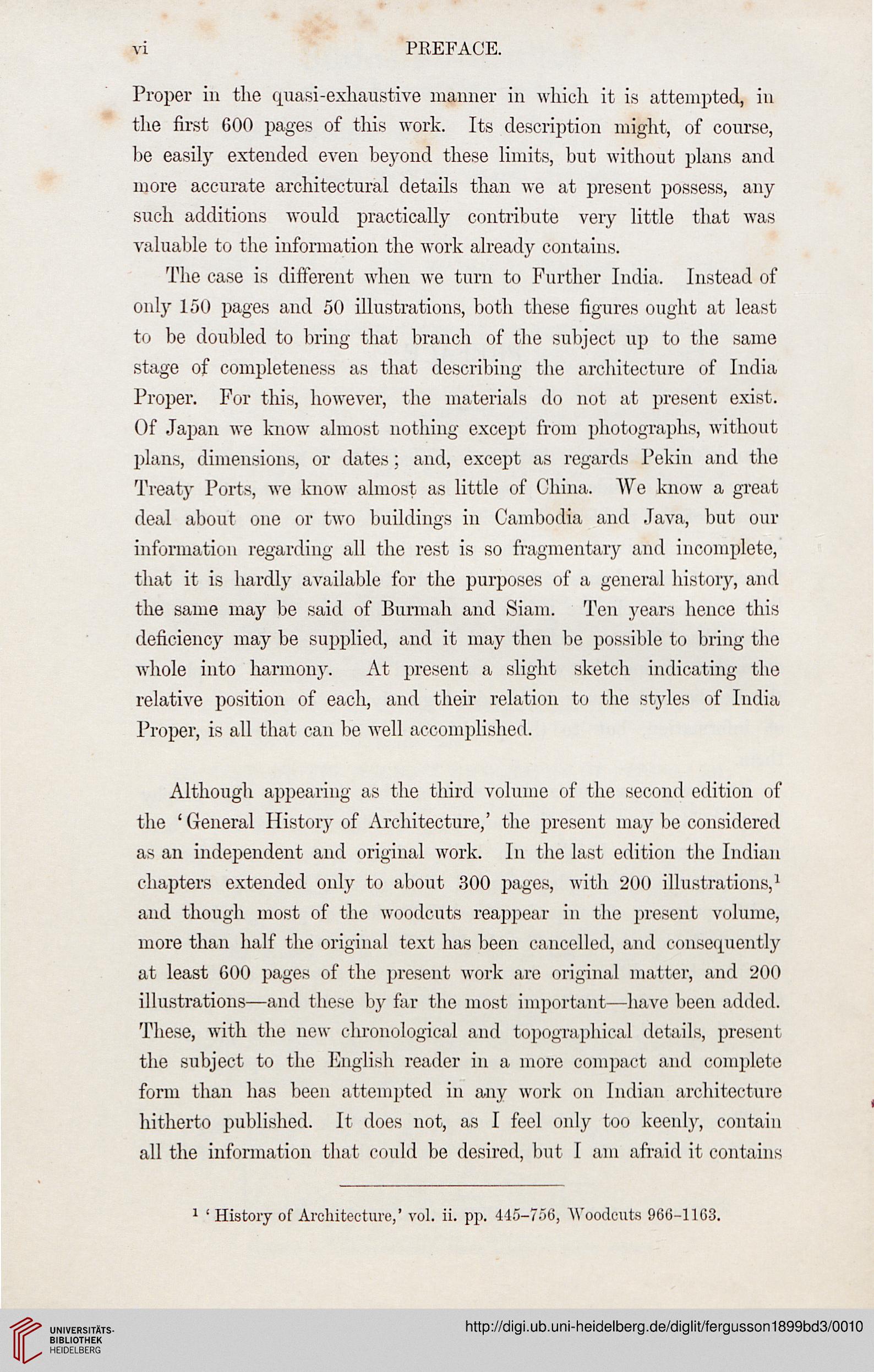vi
PREFACE.
Proper in the quasi-exhaustive manner in which it is attempted, in
the first 600 pages of this work. Its description might, of course,
be easily extended even beyond these limits, but without plans and
more accurate architectural details than we at present possess, any
such additions would practically contribute very little that was
valuable to the information the work already contains.
The case is different when we turn to Further India. Instead of
only 150 pages and 50 illustrations, both these figures ought at least
to be doubled to bring that branch of the subject up to the same
stage of completeness as that describing the architecture of India
Proper. For this, however, the materials do not at present exist.
Of Japan we know almost nothing except from photographs, without
plans, dimensions, or dates; and, except as regards Pekin and the
Treaty Ports, we know almost as little of China. We know a great
deal about one or two buildings in Cambodia and Java, but our
information regarding all the rest is so fragmentary and incomplete,
that it is hardly available for the purposes of a general history, and
the same may be said of Burmah and Siam. Ten years hence this
deficiency may be supplied, and it may then be possible to bring the
whole into harmony. At present a slight sketch indicating the
relative position of each, and their relation to the styles of India
Proper, is all that can be well accomplished.
Although appearing as the third volume of the second edition of
the ' General History of Architecture,' the present may be considered
as an independent and original work. In the last edition the Indian
chapters extended only to about 300 pages, with 200 illustrations,1
and though most of the woodcuts reappear in the present volume,
more than half the original text has been cancelled, and consequently
at least GOO pages of the present work are original matter, and 200
illustrations—and these by far the most important—have been added.
These, with the new chronological and topographical details, present
the subject to the English reader in a more compact and complete
form than has been attempted in any work on Indian architecture
hitherto published. It does not, as I feel only too keenly, contain
all the information that could be desired, but I am afraid it contains
1 ' History of Architecture,' vol. ii. pp. 415-756, Woodcuts 966-1103.
PREFACE.
Proper in the quasi-exhaustive manner in which it is attempted, in
the first 600 pages of this work. Its description might, of course,
be easily extended even beyond these limits, but without plans and
more accurate architectural details than we at present possess, any
such additions would practically contribute very little that was
valuable to the information the work already contains.
The case is different when we turn to Further India. Instead of
only 150 pages and 50 illustrations, both these figures ought at least
to be doubled to bring that branch of the subject up to the same
stage of completeness as that describing the architecture of India
Proper. For this, however, the materials do not at present exist.
Of Japan we know almost nothing except from photographs, without
plans, dimensions, or dates; and, except as regards Pekin and the
Treaty Ports, we know almost as little of China. We know a great
deal about one or two buildings in Cambodia and Java, but our
information regarding all the rest is so fragmentary and incomplete,
that it is hardly available for the purposes of a general history, and
the same may be said of Burmah and Siam. Ten years hence this
deficiency may be supplied, and it may then be possible to bring the
whole into harmony. At present a slight sketch indicating the
relative position of each, and their relation to the styles of India
Proper, is all that can be well accomplished.
Although appearing as the third volume of the second edition of
the ' General History of Architecture,' the present may be considered
as an independent and original work. In the last edition the Indian
chapters extended only to about 300 pages, with 200 illustrations,1
and though most of the woodcuts reappear in the present volume,
more than half the original text has been cancelled, and consequently
at least GOO pages of the present work are original matter, and 200
illustrations—and these by far the most important—have been added.
These, with the new chronological and topographical details, present
the subject to the English reader in a more compact and complete
form than has been attempted in any work on Indian architecture
hitherto published. It does not, as I feel only too keenly, contain
all the information that could be desired, but I am afraid it contains
1 ' History of Architecture,' vol. ii. pp. 415-756, Woodcuts 966-1103.





